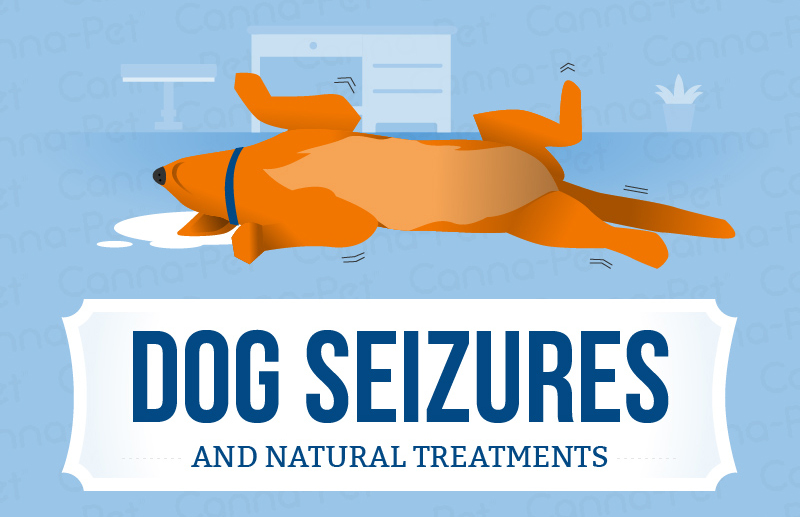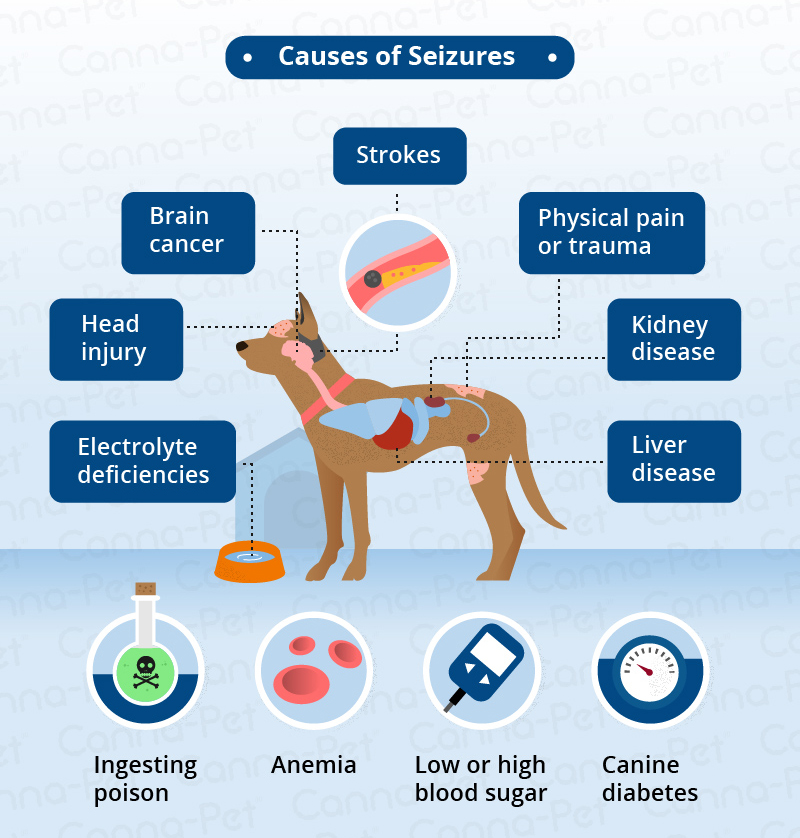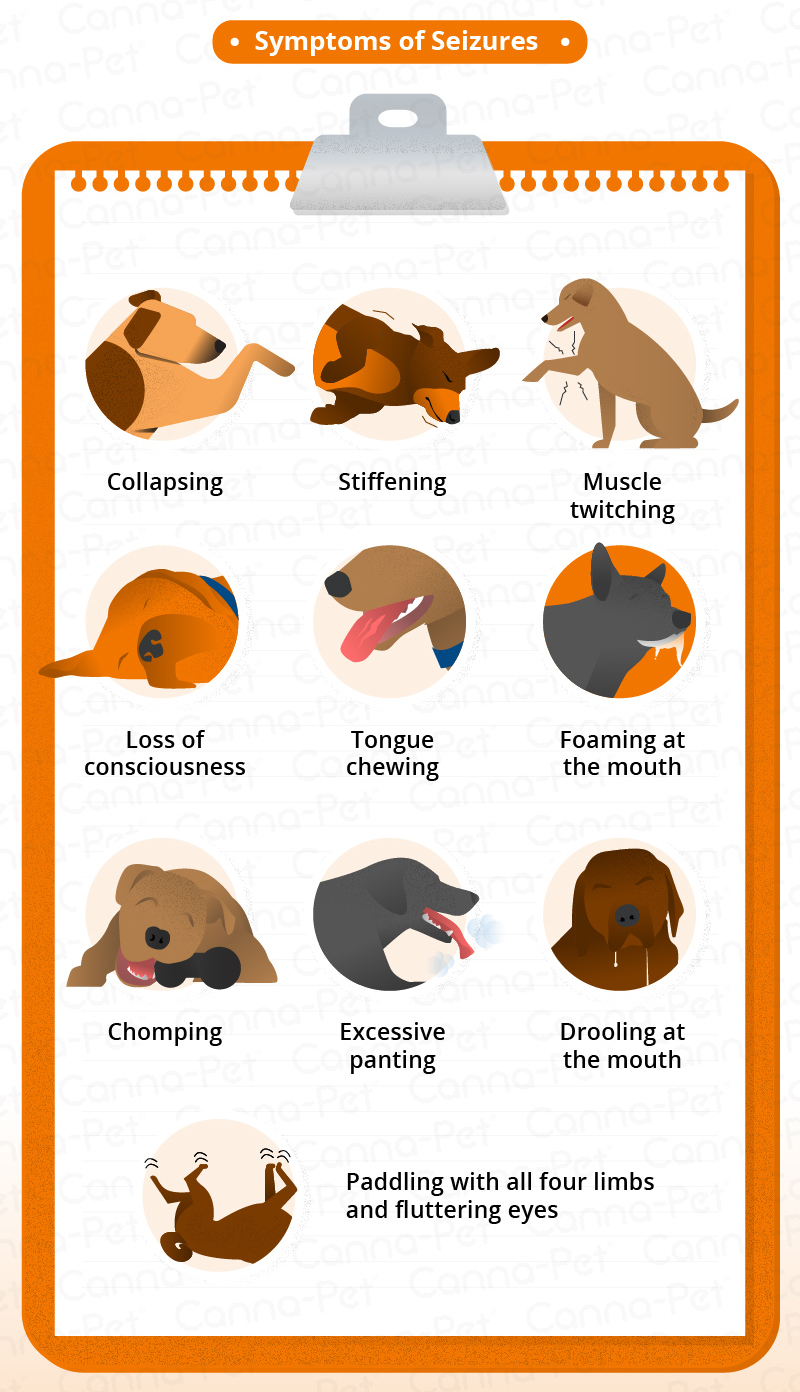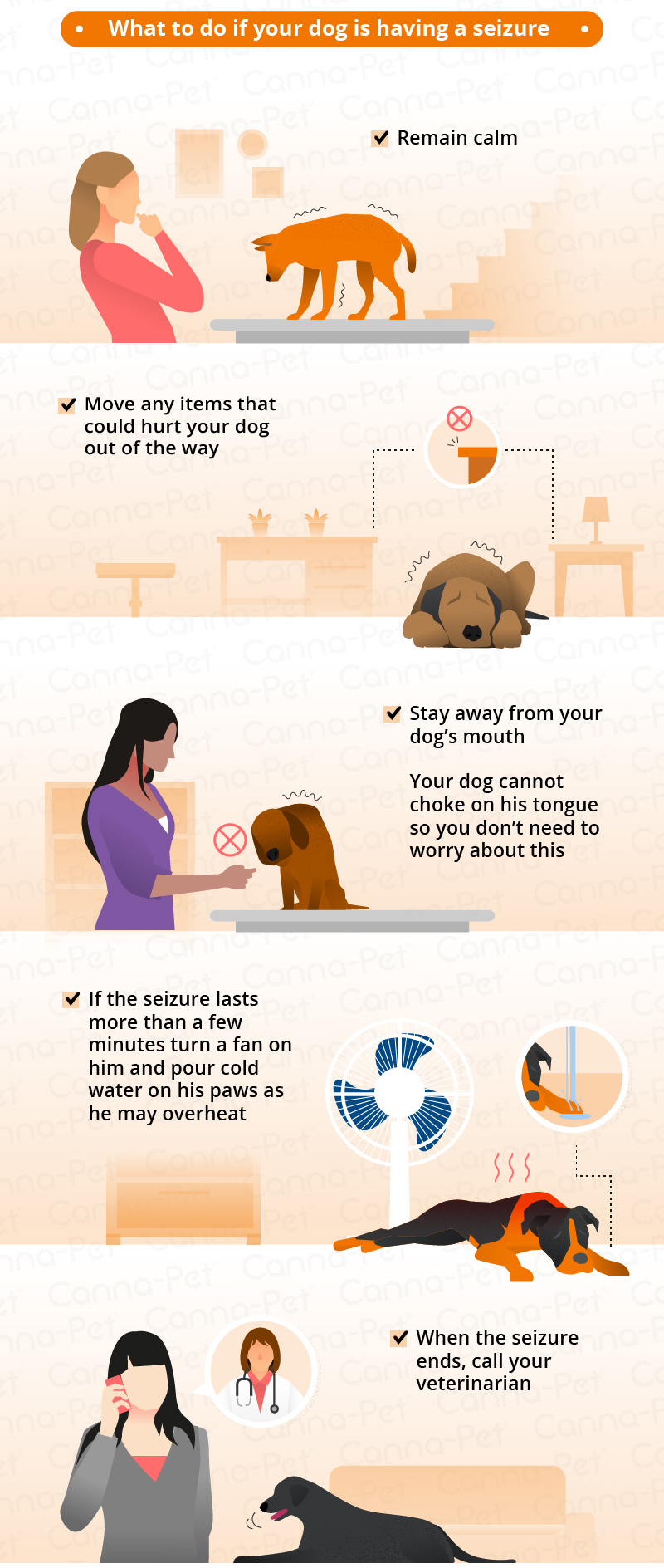Believe it or not, seizures don’t just happen to humans.
Unfortunately, many of our beloved pets suffer from status epilepticus (epilepsy), too–including dogs. Dog epilepsy is one of the “silent epidemics” that affects dogs across the world. Dog seizures aren’t spoken of as often as hip dysplasia or fleas & ticks, but that doesn’t mean it can’t happen to your dog. Studies report that Idiopathic epilepsy (the single most common canine seizure disorder) occurs in 0.5 to 5.7 percent of all dogs.
This might seem like a low number, but it still indicates that your dog can indeed have a seizure, so would you know what to do if that happens? Whether your dog has already experienced an epileptic seizure, you’d like to help prevent them from happening in the first place, or simply be prepared in how to treat dog seizures, it helps to learn as much as you can about canine epilepsy treatment.
Types of Seizures and Convulsions in Dogs
There are several different kinds of seizures in dogs:
- Epilepsy is a term used to describe recurrent or reoccurring seizures that originate from the brain.
- Idiopathic epilepsy describes a form of epilepsy that does not result in brain lesions or damage to the brain.
- Symptomatic epilepsy is used to describe primary epilepsy resulting in structural lesions or damage to the brain’s structure.
- Probably symptomatic epilepsy is a phrase used in cases of suspected symptomatic epilepsy, where a patient has reoccurring seizures, but where no lesions or brain damage is apparent.
- Cluster seizures in dogs describe any situation where an animal has more than one seizure in consecutive 24-hour periods.
- Status epilepticus involves constant seizures, or activity involving brief periods where there is inactivity, but not complete relief from seizure activity.
Unfortunately, the number of seizures your dog has is linked to neuron damage in his or her brain. This, in turn, means your pet is more likely to experience seizures again. For research purposes, most experts classify all seizures in one of three ways:
- Generalized seizures impact most of the brain and include both sides.
- Focal seizures impact only a smaller, localized portion of the brain.
- Focal seizures with secondary generalization are seizures that start out in one smaller place but then eventually lead to the rest of the brain seizing.
Signs of Seizures and Convulsions in Dogs
Just like humans, dogs often get warning signs when a seizure is coming. The warning comes in the form of an aura, not unlike the kind of aura humans with migraines and other neurological disturbances experience.
Your dog’s aura will typically make him or her feel and act stressed, scared, dazed or worried. Your pet may also experience muscle and limb contractions, visual disturbances, and even loss of bowel and bladder control. A dog with seizures can also enter into a kind of altered mental status before a seizure hits, so be on the lookout for this and other neurological symptoms.
Animals have a “sixth sense” about certain upcoming events, and canine epilepsy is one of them. Many dog owners said their pet sought companionship immediately before seizures while others may hide.
When a seizure strikes, your dog may fall on one side and become stiff. Other common symptoms include chomping, excessive panting, drooling at the mouth, vocalization, paddling with all four limbs and fluttering eyes. Your dog may also lose bladder or bowel control. The average canine seizure duration is about two minutes. If a seizure lasts over five minutes, your dog is more at risk of falling into a coma or having internal organ damage.
In the instance of a partial seizure, the seizure will only affect a small part of the dog’s brain and be seen in only one limb, one side of the body, or just its face.
Once the seizure is over, your dog may act as if nothing happened. But most post-seizure dogs will display altered behavioral characteristics for 18-24 hours afterward. This includes confusion and disorientation as well as aimless wandering, compulsive behavior, momentary blindness, pacing, increased thirst, and even increased appetite. Recovery may be immediate or take up to 24 hours.
As a general rule, younger dogs seem to have more severe epilepsy. When the onset is before the age of two, the condition will respond positively to medication. But the more seizures a dog has, the more likely there is to be damage among the neurons in the brain.
What to do when your dog is having a seizure
The first thing you need to do is remain calm. Panicking will only make your dog more anxious, your dog needs you to be a calming presence to assure him or her that they will be OK. If there is something nearby that could hurt your dog during the seizure, move it out of the way. And definitely stay away from your dog’s mouth, as you could get unintentionally bitten. Your dog can’t choke on its tongue, so you don’t need to worry about that.
If the seizure continues for more than a couple minutes, your dog will be at risk of overheating. Turn a fan on your dog and pour cold water on his paws to help him cool down. As soon as the seizure ends, make sure to call your veterinarian.
If your dog has a seizure that lasts more than 5 minutes or if he has several in a row while he’s unconscious, take him to a vet as soon as possible. The longer a seizure goes on, the higher a dog’s body temperature can rise, and he may have problems breathing. This can raise his risk of brain damage. Your vet may give your dog IV Valium to stop the seizure.
What Causes Seizures and Convulsions in Dogs?
No dogs are immune to the effects of seizures. A dog’s natural curiosity, bad luck, genetic predisposition and other factors can cause canine seizures. Other factors, like the patterns a dog’s seizures take, can affect how seizures are experienced in the future. There are many different factors that can influence the development of future seizures, including the pattern of seizures.
You should also consider your dog’s age when it first develops a seizure. This will help determine if it is more or less likely to have future seizures, recurrent seizures, as well and the frequency and outcome.
Here are a few causes of dog seizures:
- Anemia
- Canine diabetes
- Ingesting poison
- Liver disease
- Physical pain or trauma
- Strokes
- Low or high blood sugar
- Kidney disease
- Electrolyte deficiencies
- Head injury
- Encephalitis
- Brain cancer
It’s difficult to pinpoint the cause of a dog’s seizures, so if you’re not sure, seek veterinary advice.
Idiopathic epilepsy is a type of canine seizure with no known or obvious causes. Idiopathic epilepsy is known to be genetic in many dog breeds and is also runs in certain families or lines of animals. These breeds of dog should be tested for epilepsy and if diagnosed, should not be used for breeding.
Breeds that are more susceptible than others to this type of seizure include Border collies, Australian shepherds, Labrador retrievers, Beagles, Belgian Tervurens, and German Shepherds, Vizslas, Shetland Sheepdogs and Keeshonds are breeds that are afflicted with higher rates of idiopathic epilepsy.
Genetic epilepsy typically occurs in dogs between 10 months and three years of age, but has been documented in dogs as early as six months and as late as five years.
Symptoms of Epilepsy in Dogs
Symptoms of seizures in dogs can include collapsing, jerking, stiffening, muscle twitching, loss of consciousness, drooling, chomping, tongue chewing or even foaming at the mouth. Dogs will typically fall to one side or the other and make paddling motions with their legs. They sometimes poop or pee during the seizure.
Before a seizure, dogs may look dazed, seem unsteady or confused, or stare off into space. After the seizure ends, your dog may seem disoriented, wobbly or even temporarily blind. The dog may walk in circles and bump into things. Some may have a lot of drool on their chin and could even be bleeding in the mouth if the dog bit itself. Your dog may even try to hide.
Natural Remedies for Seizures in Dogs – Dog Seizure Treatment that Works
Seizures and epilepsy in dogs can be frustrating, because your dog may often recover before you even make it in to see your veterinarian. But there are plenty of natural remedies for canine seizures available to help with your epileptic dog.
As canine epilepsy research continues to mount, it’s becoming increasingly clear that pet nutrition – similar to human dietary habits – can play a vital role in disease prevention and longevity. The nutritional profile of dog food and snacks should ideally contain beneficial phytochemicals and antioxidants, which serve as neuroprotectants, reduce inflammation, ward off disease, and optimize nutrient absorption.
Aside from the anti-inflammatory effects, canine dietary habits should also strive to strengthen your dog’s overall immune system function. A robust immunity response is vital in preventing relatively small issues from becoming serious health issues. Researchers are currently working on studies that examine the relationship between immune system health and the onset of seizures.
Naturally, in certain cases your dog may need more intervention. When tumors are the source of seizures in dogs, or when they make them worse, surgery may be necessary. In other animals it may be necessary to control or mitigate against seizures with drugs.
Which types of drugs work to help lessen or prevent your pet’s seizures will depend on several factors. Seizures may be controlled by anti-convulsant drugs, anti-epileptic medications, or even corticosteroid drugs. However, the nature of your dog’s seizures, the type of epilepsy the animal has, and existing health history will control what works and what doesn’t. Corticosteroids, for example, should be avoided in cases where your pet is suffering from an infectious disease.
Managing Your Pet’s Seizures Day to Day
Seizures are best dealt with head-on, so early detection and treatment are essential. Several more severe varieties of epilepsy strike younger dogs more often than others, so at the first sign of trouble, get your pet a complete examination with a veterinarian. Even if your dog doesn’t have idiopathic or primary epilepsy or another severe variety of epilepsy, this will ensure that your family has the right care plan in place for your pet.
Breeds More Likely to Experience Epilepsy and Seizures
Remember, any age, breed, or temperament of dog can experience seizures. High incidences are seen in Border collies, Australian shepherds, Labrador retrievers, beagles, Belgian Tervurens, Collies, German Shepherds, Shetland Sheepdogs, Golden Retrievers, Keeshonds, Vizslas, Finnish spitz, Bernese Mountain Dogs, Irish Wolfhounds, and English Springer Spaniels.
Hemp, Seizures, and the ECS System
Hemp for Intractable Epilepsy by Narda Robinson, DO, DVM
Originally published in the June 2014 issue of Veterinary Practice News – see original text for citations.
hemp reduces pain, inflammation, and anxiety as well as seizure activity…
Decades of research indicate that hemp yields notable anticonvulsant effects with minimal neurotoxicity. It reliably reduces neuronal activity and seizure severity… hemp affects several endogenous pathways simultaneously, demonstrating a multiplicity of neuropharmacologic mechanisms of action.
It works additively and at times synergistically with other anti-epileptic drugs; this allows clinicians to more readily introduce hemp into a seizure patient’s drug regimen without reducing the effectiveness of pharmaceuticals already “on board.”
As it turns out, the nervous, lymphatic and possibly other systems within the body already house receptors, making them already prepared to respond to both phyto- and endo-compounds. regulates neuronal excitability. When it falters, an “ECS deficiency syndrome” may result, associated not only with seizures but also with the onset of fibromyalgia, irritable bowel syndrome, migraine and other maladaptive states…
In fact, many integrative approaches for epilepsy also affect ECS states, including acupuncture along with certain nutritional supplements, herbal medicines, dietary changes, and, of course, hemp.
Canna-Pet® for Dog Seizures – Hemp Nutrition
A recent study by Colorado State University found that among those with an opinion, 92% of Canna-Pet® customers reported that our pet CBD products (including our CBD dog treats) helped to relieve dog seizures in dogs or convulsions a moderate amount or a lot.











